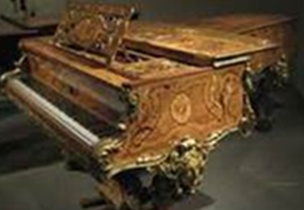The Basics, Placement
There are 2 “nevers” for piano placement, never in direct sunlight,
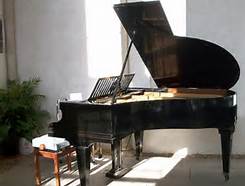 this
means checking if the sun will be shining on the piano during any portion of the day. The 2nd never is never in direct heat, in other words if a heat register will
be blowing on it(or for that matter an A/C vent) either move the piano, close the vent or purchase a deflector to deflect the direct heat away from the piano.
this
means checking if the sun will be shining on the piano during any portion of the day. The 2nd never is never in direct heat, in other words if a heat register will
be blowing on it(or for that matter an A/C vent) either move the piano, close the vent or purchase a deflector to deflect the direct heat away from the piano.
Finish Care
The most important suggestion I can make is to keep all drinks off the piano, they can not only mar the finish but if spilled
can leak inside doing much more damage.
When you dust try to dust in the direction of the grain on wood finished pianos, dust can be abrasive which is why dry dusting,
unless a special duster, Swiffer or any of the electrostatic dusting materials are used, they pick up the dust instead of “pushing it around”. The 2
types of piano finishes found on pianos today, lacquer on older pianos and polyester/polyurethane on newer ones may also be wiped down with a clean slightly damp
cloth. Spray type polishes are not recommended. Cory makes piano specific polishes for the differing finishes which I offer, along with their key cleaning liquid.
Tuning-How often?
Most manufacturers recommend tuning a new piano 3 to 4 times the first year and twice a year after that.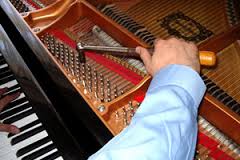
I find in my experience I have some customers that tune their pianos more often than twice a year and others that once a year
works for them just fine. The large seasonal changes are most noticable after the onset of heating season in the fall and after the end of heating season in the
late spring/early summer.
General Rules of Care
Keep the piano tuned and try not to overfill the bench (the bottoms break out easily), wipe off the keys periodically with a
damp cloth.
Play the piano regularly, a played piano is a happy piano!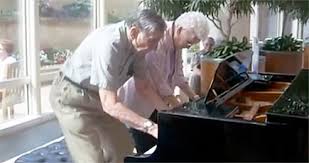
Do not try to make repairs yourself. I carry a supply of parts, specialty tools, which I paid for years ago& the correct glues. Frequently I have found it is more expensive to re-repair a do-it-yourselfer’s good intentions, than for me to just repair it in the first place.
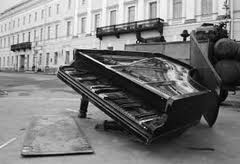
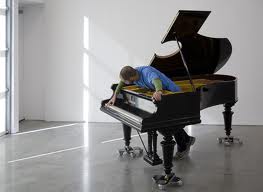
Humidity Control Systems and Your Piano
Much of your piano is wood, which changes size and shape as the humidity in the room rises and falls. When the humidity increases,
wood swells; and when it decreases, the wood shrinks.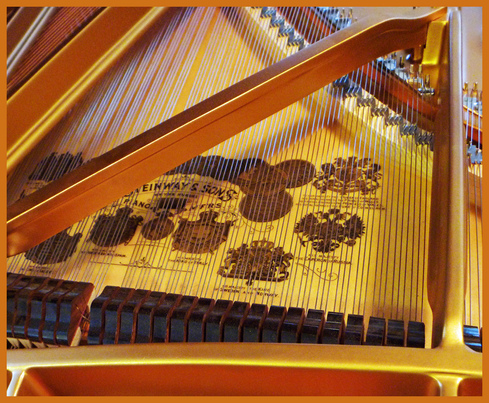
When the wood in your piano swells or shrinks, the tuning changes as the string tension goes up and down. That is why pianos
tend to be sharp in the summer and flat in the winter. Note the string travel at right it's high point is the bridge(gray/black
zigzag on maple)which is glued to the spruce soundboard which swells with humidity & shrinks back when it dries
Humidity also affects other wooden parts of the piano, including the pinblock, soundboard, and bridges.
Tuning pins are held tight by the wooden pinblock. If a pinblock dries out too much, the piano will not stay in tune because
the tuning pins can’t resist the string tension.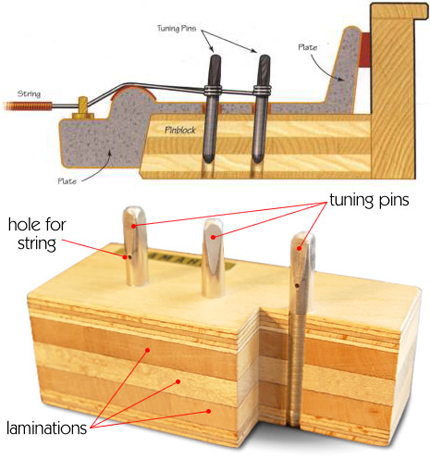
Your piano’s soundboard and bridges, which can crack if they get too dry, are critical for good tone and volume. They
can be repaired, but avoiding the problem is a better solution.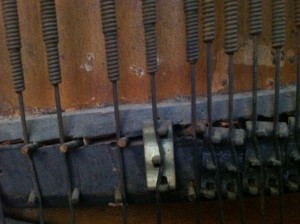 Note the cracked bridge from years of excessive humidity & dryness at left & it's replacement below!
Note the cracked bridge from years of excessive humidity & dryness at left & it's replacement below!
You can keep track of your piano’s humidity with a hygrometer (humidity meter). Both pianos and humans are at their best
when the humidity is between 40% and 50%, so you will both benefit.
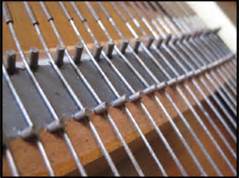
For long-term humidity control, you might consider installing a Dampp-Chaser system to automatically monitor and control the
humidity inside your piano. Call or email for more information.
Contact us in West Salem, Wisconsin, at (608) 608-786-4404 for piano humidity control that will keep your piano playing
& sounding like new!

